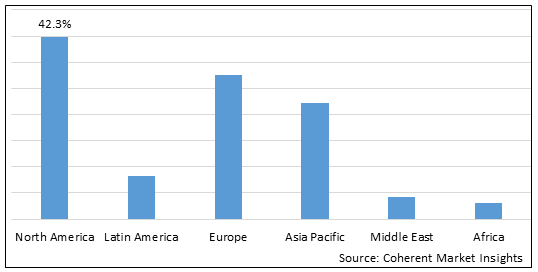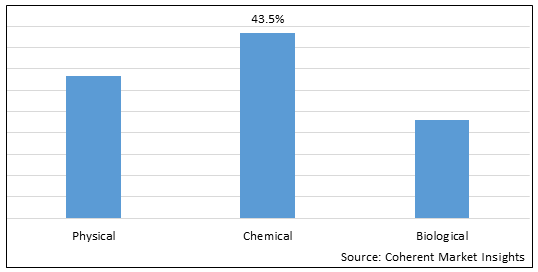Anti-Biofilm Wound Dressing Market is estimated to be valued at USD 945.6 Mn in 2025 and is expected to reach USD 2,294.4 Mn in 2032, exhibiting a compound annual growth rate (CAGR) of 13.5% from 2025 to 2032. The anti-biofilm wound dressing market is experiencing strong growth due to the increasing prevalence of chronic diseases and increasing prevalence of chronic wounds across the world. Moreover, high demand for wound care products and increasing number of surgical procedures around the world is expected to boost the growth of the market. However, factors such as high cost of treatment and increasing use of advanced wound care products are expected to hamper growth of the global anti-biofilm wound dressing market.
Global Anti-Biofilm Wound Dressing Market: Regional Insights
Based on geography, the global anti-biofilm wound dressing market is segmented into North America, Latin America, Europe, Asia Pacific, Middle East, and Africa.
Among regions, North America is expected to gain highest share in the market during the forecast period owing to the increasing incidence of chronic and autoimmune diseases, increasing incidence of chronic or acute wounds, growing number of surgical procedures, and introduction of advanced wound care products in the region. For instance, according to the article published by the Agency for Healthcare Research and Quality, each year, over 2.5 million people in the United States suffer from pressure ulcers, and the cost of individual patient care ranges from US$ 20,900 to 151,700. This in turn is expected to increase demand for anti-biofilm wound dressing in the region.
Europe and Asia Pacific are also expected to witness significant growth in the global anti-biofilm wound dressing market due to the rise in burden of chronic and autoimmune diseases, increasing number of surgical procedures, increasing incidence of chronic and acute wounds, and increasing number of wound care clinics in Europe and Asia Pacific. For instance, diabetic patients are prone to getting ulcers, and is expected to increase demand for anti-biofilm wound dressing. According to the World Health Organization (WHO), around 60 million people in the Europe currently living with diabetes or about 10.3% of men and 9.6% of women aged 25 years and over.
Figure 1. Global Anti-Biofilm Wound Dressing Market Share (%), by Region, 2025

To learn more about this report, Download Free Sample
Global Anti-Biofilm Wound Dressing Market Drivers:
Rise in burden of chronic diseases to drive market growth
One of the key factors expected to augment the growth of the global anti-biofilm wound dressing market during the forecast period is the increasing prevalence of chronic diseases across the world. Increasing prevalence of chronic diseases, such as diabetes, contributes to the increase in chronic wounds. Diabetic foot ulcers are the most common chronic wounds and generate the major global problem with high management costs. According to the International Diabetes Federation (IDF), around 537 billion people (aged 20 to 79 year) are living with diabetes, and the number is expected to reach around 643 billion by 2030 and 783 billion by 2045.
Increasing prevalence of chronic wounds to propel market growth
Another factor which is driving the growth of the global anti-biofilm wound dressing market is the increasing prevalence of chronic wounds worldwide. For instance, with the increasing prevalence of chronic wounds across the globe, the demand for anti-biofilm wound dressing is also increasing rapidly. According to the article published in Healogics, a provider of advanced wound care, more than 7 million people in the United States are living with a chronic wound, and this has prompted a 50% increase in amputations during the pandemic. Moreover, with the rise in burden of diabetes, the prevalence of chronic wounds is also increasing worldwide.
Global Anti-Biofilm Wound Dressing Market Opportunities:
Increasing number of surgical procedures across the globe is expected to offer significant growth opportunities for players in the global anti-biofilm wound dressing market. For instance, with the rise in burden of chronic diseases, the number of surgical procedures is also increasing, as chronic diseases leads to an increased number of surgical procedures. According to the National Institute of Health (NIH), each year, around 310 million major surgeries are performed worldwide, around 40 to 50 million in the United States and around 20 million in Europe. This in turn is expected to augment the growth of the anti-biofilm wound dressing market.
Increasing demand for wound care products is expected to offer lucrative growth opportunities for players in the global anti-biofilm wound dressing market. For instance, with the rise in burden of chronic disease, increasing number of road accidents, and growing number of surgical procedures, the demand for novel wound care products is also increasing across the globe. In April 2021, Imbed Biosciences announced the launch of its novel FDA (Food and Drug Administration) cleared next-generation antimicrobial matrix product, Microlyte Matrix. These products are designed for use in the management of surgical, traumatic, and chronic wounds.
Anti-Biofilm Wound Dressing Market Report Coverage
| Report Coverage | Details | ||
|---|---|---|---|
| Base Year: | 2024 | Market Size in 2025: | USD 945.6 Mn |
| Historical Data for: | 2020 To 2024 | Forecast Period: | 2025 To 2032 |
| Forecast Period 2025 to 2032 CAGR: | 13.5% | 2032 Value Projection: | USD 2,294.4 Mn |
| Geographies covered: |
|
||
| Segments covered: |
|
||
| Companies covered: |
3M, Convatec Group PLC, Smith & Nephew PLC, Urgo Medical, and Coloplast Corporation, among others. |
||
| Growth Drivers: |
|
||
| Restraints & Challenges: |
|
||
Uncover macros and micros vetted on 75+ parameters: Get instant access to report
Global Anti-Biofilm Wound Dressing Market Trends:
High demand for anti-biofilm dressing products is a recent trend
Chronic wounds take more time to heal and are expensive to treat. While, anti-biofilm dressing is an ideal and standard solution to treat chronic wounds. Traditional wound care products are being increasingly replaced with advanced wound care products due to their effectiveness and efficiency in managing wounds by enabling faster healing. Thus, there is an increasing demand for chemical anti-biofilm dressing products. Moreover, players in the market are focusing on developing and launching novel/innovative products in the market to meet growing demand. This trend is expected to continue over the forecast period.
Increasing number of road accidents is another trend
According to the Association for Safe International Road Travel, around 1.35 million people die every year in a road crash, whereas on average 3,700 people lose their lives every day on the road. Moreover, according to the National Highway Traffic Safety Administration, road accidents were responsible for more than 42,000 fatalities in 2021 in the U.S., around 10.5% increase as compared to 38,824 fatalities reported in 2020. Thus, increasing number of accidents is expected to increase the demand for anti-biofilm wound dressing products. This trend is also expected to continue over the forecast period, driving the market growth.
Global Anti-Biofilm Wound Dressing Market Restraints:
High cost of treatment to hamper growth of the market
One of the key factors expected to hinder growth of the global anti-biofilm wound dressing market is the high cost of treatment. Wound care take a longer time to heal and require a large number of resources for their treatment. For instance, stage IV pressure ulcer causes considerable pain, which adds around three months or longer to hospital stays, which in turn increase the burden on patients. Moreover, wound infection can lead to inflammation and pain, which further increase the need for surgical interventions or dressings such as anti-biofilms to reduce wound infections. This in turn increase the cost of treatment, restraining the growth of the market.
Increasing use of advanced wound care products to hinder market growth
Another factor which is hampering the growth of the global anti-biofilm wound dressing market is the increasing use of advanced wound care products. For instance, growing adoption of advanced wound care products to treat complex wounds is expected to hamper the adoption of anti-biofilm wound dressing products. The use or demand for advanced wound care products has increased due to various benefits associated with advanced wound care products. Therefore, increasing usage of advanced wound care products as effective wound care treatments is expected to hinder growth of the global anti-biofilm dressing market.
Figure 2. Global Anti-Biofilm Wound Dressing Market Share (%), by Region, 2025

To learn more about this report, Download Free Sample
Global Anti-Biofilm Wound Dressing Market Segmentation:
The global anti-biofilm wound dressing market report is segmented into Mode of Mechanism, Application, and Region.
Based on Mode of Mechanism, the market is segmented into Physical, Chemical, and Biological. Out of which, Physical Segment is expected to dominate the anti-biofilm wound dressing market during the forecast period and this is attributed to the increasing prevalence of chronic and surgical wounds around the world.
Chemical Segment is also expected to witness robust growth in the near future and this is due to the increasing prevalence of chronic wounds and increasing number of surgeries across the globe.
Based on Application, the market is segmented into Acute Wounds and Chronic Wounds. Out of which, Acute Wounds Segment is expected to dominate the market over the forecast period and this is attributed to the increasing number of patients suffering from acute wounds.
Chronic Wounds Segment is also expected to witness significant growth in the near future and this is owing to rise in burden of chronic disease across the globe.
Global Anti-Biofilm Wound Dressing Market: Key Developments
In October 2021, Imbed Biosciences Inc. received US$ 800,000 in a Commercialization Readiness Pilot (CRP) grant from the National Institute for Arthritis and Musculoskeletal and Skin Diseases (NIAMS) to support late-stage development of the next-generation wound dressing that can kill bacteria hidden inside the biofilms in wounds and accelerate wound healing.
Global Anti-Biofilm Wound Dressing Market: Key Companies Insights
The global anti-biofilm wound dressing market is highly competitive. This is attributed to the rise in demand for anti-biofilm wound dressing products, as a result, players in the market are focusing on launching novel products in the market.
Some of the key players in the global anti-biofilm wound dressing market are 3M, Convatec Group PLC, Smith & Nephew PLC, Urgo Medical, and Coloplast Corporation, among others.
*Definition: Anti-biofilm dressing products help manage large wounds, thus, reducing the risk of infection. Anti-biofilm agents can be used to prevent biofilm formation or to prevent reformation after debridement, thereby improving the wound healing. Treating wounds with an antimicrobial or bacteriostatic dressing in an alginate or polymeric foam form will help prevent reformation of biofilms.
Share
Share
About Author
Manisha Vibhute is a consultant with over 5 years of experience in market research and consulting. With a strong understanding of market dynamics, Manisha assists clients in developing effective market access strategies. She helps medical device companies navigate pricing, reimbursement, and regulatory pathways to ensure successful product launches.
Missing comfort of reading report in your local language? Find your preferred language :
Transform your Strategy with Exclusive Trending Reports :
Frequently Asked Questions
Select a License Type
Joining thousands of companies around the world committed to making the Excellent Business Solutions.
View All Our Clients